
Elements of the engine power system: 1 - fuel filter; 2 - fuel tank; 3 - adsorber; 4 - ventilation tube; 5 - filling pipe; 6 - tube for supplying air to the adsorber; 7 - fuel module; 8 - tube of the discharge line; 9 — a tube of a drain line; 10 - gravity valve; 11 - corrugated hose for supplying air to the throttle assembly; 12 - throttle assembly; 13 - adsorber purge valve; 14 - inlet pipeline; 15 - vacuum reservoir assembly with the valve of the system for changing the length of the intake tract; 16 - fuel rail; 17 - exhaust gas recirculation valve; 18 - recirculation valve spacer; 19 - nozzles; 20 - air filter; 21 - resonator; 22 - air intake; 23 - tee
Fuel is supplied from a tank installed under the bottom near the rear seat. The fuel tank consists of two forged steel parts welded together. The filler neck is connected to the tank with a plastic petrol-resistant tube, fixed to the tank pipe with a clamp. Valves are installed in the filler cap to prevent deformation of the tank when the pressure inside it changes. The upper parts of the filling pipe and the fuel tank are connected by a plastic ventilation tube, which serves to vent the air forced out of the tank when refueling.
A fuel module is installed in the tank, which includes a fuel pump, a fuel pressure regulator, a fuel gauge sensor and a fuel reserve indicator lamp resistor.
To access the fuel module under the rear seat cushion in the bottom of the car there is a hatch closed with a lid.
The fuel gauge sensor sends signals to the gauge located in the instrument cluster.
The fuel pump is located inside the fuel module housing.

Fuel module: 1 — module case; 2 - fuel pressure regulator; 3 — module cover; 4 - fitting of the drain line; 5 - fitting of the discharge line; 6 - electrical connector; 7 - float sensor fuel gauge; 8 — the resistor of a control lamp of a reserve of fuel; 9 - fuel gauge sensor

Fuel pump
The fuel pump is made as a non-separable unit and must be replaced if it fails. A strainer is installed at the pump inlet.
Pump productivity not less than 60 l/h.
From the pump, pressurized fuel is supplied to the fuel filter

Fuel filter
Fine fuel filter - non-separable, in a metal case, with a paper filter element. The filter is attached to the fuel tank at the front right. After the filter, the fuel is supplied to the tee and through it to the fuel rail and the fuel pressure regulator located in the fuel module.
The fuel pump creates excess pressure in the system that exceeds the operating pressure of the fuel injectors.
The fuel pressure regulator ensures that excess fuel is discharged through the drain line into the fuel tank.

Fuel pressure control
The fuel pressure regulator is non-separable; if it fails, it must be replaced. During engine operation, the regulator maintains pressure in the discharge line within 2.8–3.3 bar.
The fuel rail is a metal tube with injectors mounted on it.
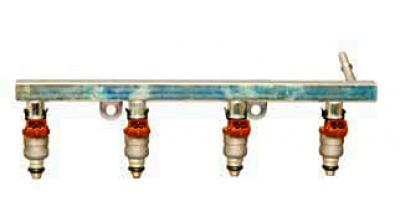
Fuel rail assembly with injectors
The ramp is attached to the intake manifold with two bolts.
The nozzle is fixed on the ramp with a metal locking bracket and sealed in the ramp and inlet pipeline with rubber rings.
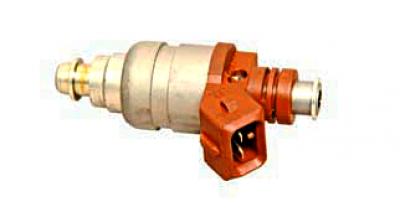
Nozzle
At the nozzle outlet there is a sprayer with two nozzles through which fuel is injected into the inlet channel of the pipeline.

The spray nozzle
Controls the operation of the ECU injectors (electronic control unit). In the event of an open or short circuit in the nozzle winding, the latter should be replaced. If the nozzles are clogged, they can be washed without dismantling at a special service station stand.
Air enters the engine through the air intake, resonator, air filter, corrugated rubber hose, throttle assembly and intake manifold.
The air filter with a replaceable paper element cleans the intake air, while the resonator dampens intake air noise. The air intake and resonator are located under the right front fender, while the air filter is located in the front of the engine compartment on the right.
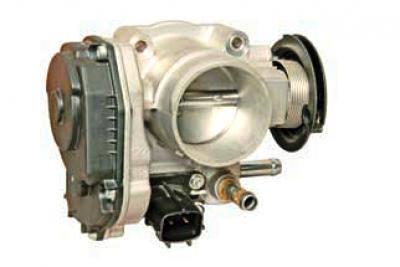
Throttle assembly
The throttle assembly is attached to the intake manifold and is a throttle body on which the idle air control and throttle position sensor assembly is installed. To prevent freezing of the throttle assembly at low temperatures and high ambient humidity, a heating unit is built into the assembly, through which the cooling system fluid circulates. When you press the "gas" pedal, the throttle valve opens, changing the amount of air entering the engine (fuel supply is calculated by the ECU depending on the air flow). When the engine is idling (throttle valve closed) The ECU controls the air supply using the idle speed controller, combined with the throttle position sensor into one unit.
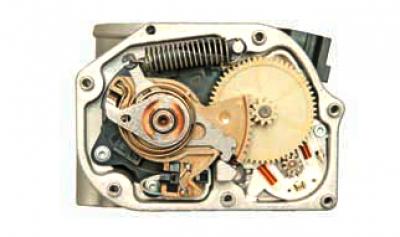
idle speed controller
For all engine operating modes, the ECU is programmed (calibration) required idle speed, depending on the coolant temperature, vehicle speed, voltage at the battery terminals and the condition of the air conditioning system.
The regulator consists of an electric motor and a gearbox that transmits rotation from the electric motor shaft to the throttle valve shaft. The throttle valve opening angle at idle speed is 0-24°. If the idle speed controller fails, the entire throttle assembly must be replaced.
After passing the throttle assembly, air enters the intake manifold. From the common cavity of the inlet pipeline - the receiver - air is supplied through four separate channels to the inlet channels of the cylinder head.
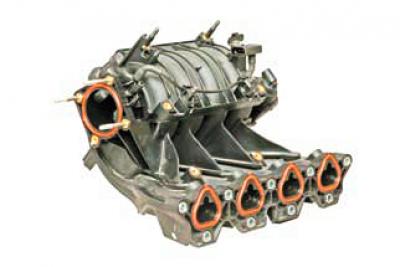
intake pipe receiver
To improve the filling of cylinders in the entire range of loads and engine speeds, a system for changing the length of the intake tract was used.
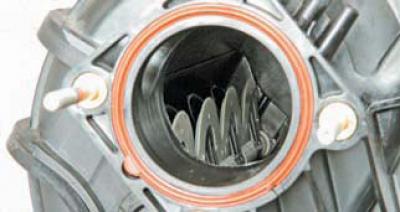
The location of the dampers of the system for changing the length of the intake tract in the intake manifold receiver
The design of the intake piping allows, by commands from the ECU, to change the length of the channels for supplying air to the engine cylinders. To do this, four dampers are installed in the intake piping receiver on a common shaft (one for the channels of each cylinder). When the valve shaft is turned, the dampers open some channels and close others, directing air into the engine cylinders either along a short or a long path.
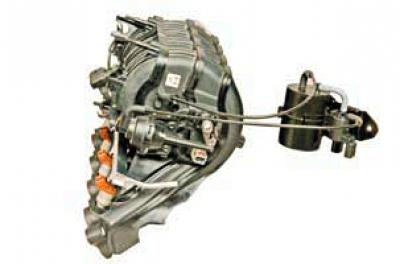
Elements of the system for changing the length of the intake tract
At low crankshaft speeds, a long intake tract provides high torque and good engine response; at higher speeds, the short intake tract allows the engine to develop high power.
The shaft with dampers is turned by the actuator of the system, which consists of a pneumatic chamber, a vacuum reservoir, tubes and an electromagnetic valve.
The vacuum reservoir of the system is connected by a tube to the internal cavity of the receiver, and by a hose to the solenoid valve.
When the engine is running, the valve opens at the command of the ECU, transferring vacuum from the reservoir to the pneumatic actuator, which rotates the axis of the dampers.
To reduce exhaust emissions (by reducing the formation of nitrogen oxides) an exhaust gas recirculation system is provided. The principle of its operation is to reduce the combustion temperature of the fresh air-fuel mixture in the engine cylinders by "diluting" it with exhaust gases taken from the exhaust manifold. The system consists of a recirculation valve fixed through a spacer on the left end of the cylinder head, channels in the exhaust manifold and cylinder head, as well as a corrugated metal tube connecting the spacer to the intake manifold.
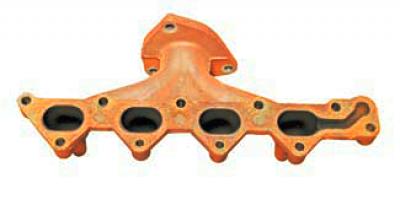
Exhaust gases are taken from the exhaust manifold through a channel made in the flange of the pipe of the 4th cylinder..
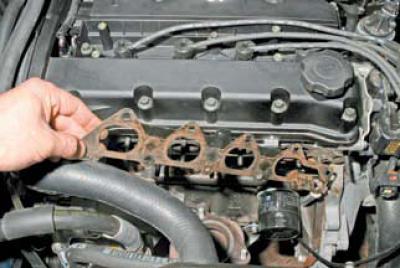
... and are fed through a channel in the cylinder head to the exhaust gas recirculation valve (through spacer).
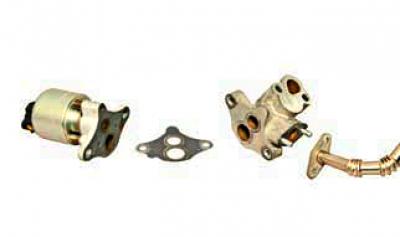
Elements of the exhaust gas recirculation system: valve; metal gasket; spacer; corrugated tube
Depending on the mode of operation of the engine, according to the signals of the electronic control unit, the recirculation valve regulates the amount of exhaust gases entering the afterburning in the intake pipeline.
The power system includes a fuel vapor recovery system, including an adsorber installed under the bottom of the vehicle near the rear right wheel, and an adsorber purge solenoid valve attached to the intake manifold bracket.
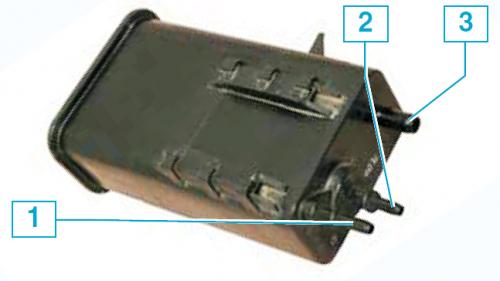
Adsorber: 1 - fitting PURGE of the pipe for removing fuel vapors from the adsorber to the valve; 2 - fitting TANK of the tube for supplying fuel vapor from the tank to the adsorber; 3 - ventilation fitting AIR
Fuel vapors from the tank enter the adsorber (activated carbon container) through the fitting labeled TANK, where they accumulate while the engine is not running. The second fitting of the adsorber with the inscription PURGE is connected by a tube to the canister purge solenoid valve, and the third one with the inscription AIR is connected to the atmosphere.
When the engine is stopped, the purge solenoid valve is closed, in which case the adsorber does not communicate with the intake manifold.
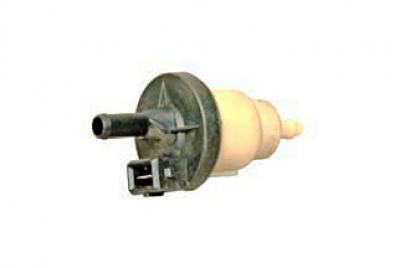
Canister purge valve
When the engine is running, the electronic unit, controlling the solenoid valve, purges the adsorber with fresh air due to rarefaction in the intake manifold.
Gasoline vapors are mixed with air and discharged into the intake manifold and then into the engine cylinders. The greater the air consumption by the engine, the longer the duration of the control pulses of the electronic unit and the more intense the purge.
